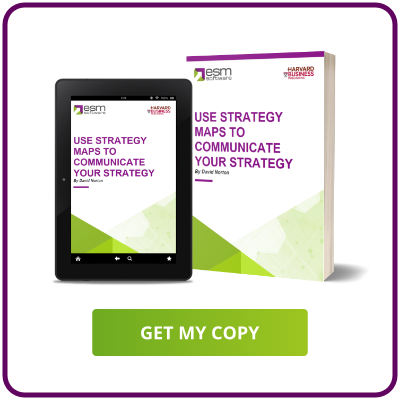The Balanced Scorecard (BSC) and Objectives and Key Results (OKR) are frameworks I have often seen pitted against one another for management attention. I’ve had organizations say they finally got serious about their strategy and upgraded from an OKR program to a Balanced Scorecard. I’ve also had organizations say their BSC is too heavy and introduce OKR as their new strategy management system. After 25 years helping organizations implement strategy, I can confidently say there is a place for both frameworks in your strategy implementation. While they each have their own idiosyncrasies, they can complement each other really well when deployed correctly.
I’ll assume most readers know that the BSC is a strategic management framework that focuses on four perspectives of an organization's performance: financial, customer, internal processes, and talent and technology. It helps organizations track progress towards achieving goals and objectives by measuring performance in each of the four areas. The BSC also includes a set of measures that are used to evaluate progress.
Less familiar to some is the OKR framework. Fundamentally, OKRs are a goal-setting framework that help organizations set and track measurable objectives and key results. They are typically used to align individual and team goals with the broader organizational goals. OKRs consist of a set of objectives, which are the specific outcomes that an organization wants to achieve, and key results are the metrics used to measure progress towards those objectives. I’ve seen OKRs implemented purely as an employee performance management system as well as implemented as a business monitoring system.
From what I’ve seen over the years, OKRs typically capture more tactical work effort by teams and individuals and link that work back to the strategy so that the employee has a firm understanding for how the work they do is connected to the strategy. OKRs tend to link from the BSC objectives, sometimes the initiatives, and  less commonly, from the measures. The “objectives” in OKRs are specific, measurable, and time-bound goals (usually monthly or quarterly) that define what the employee wants to achieve. The “key results” in the term OKR are measurable outcomes that define how the employee will achieve the objectives. Like with the BSC, there can be one or several key results per objective and they should be quantifiable, stretch/challenge the employee, and have a specific time frame.
less commonly, from the measures. The “objectives” in OKRs are specific, measurable, and time-bound goals (usually monthly or quarterly) that define what the employee wants to achieve. The “key results” in the term OKR are measurable outcomes that define how the employee will achieve the objectives. Like with the BSC, there can be one or several key results per objective and they should be quantifiable, stretch/challenge the employee, and have a specific time frame.
The BSC and OKR frameworks complement each other really well when leadership align around the need for both a high level 3-5 year strategy (BSC) coupled with shorter term objectives that break down that 3-5 year strategy into monthly and quarterly goals (OKR). Depending on the size of your organization will speak to if the BSC is cascaded from the enterprise to divisions and then into OKRs or if the enterprise BSC is immediately aligned to OKRs.
Regardless, the process must start by articulating your organization’s strategy with a BSC. Identify the 10-15 strategic objectives that your leadership believe will help you achieve your mission and vision. Identify supporting measures for the BSC so that you can communicate the desired level of performance. From there, educate the organization on your BSC(s) and ask employees to then build OKRs for the coming month/quarter that align to the organization’s goals.
Key to a successful BSC OKR marriage include:
Alignment: The BSC helps organizations translate their mission and vision into an actionable 3-5 year game plan. The most successful aspect about the BSC is that it bridges the gap from the strategic plan into executable goals and performance metrics. The BSC is typically created by the executive leadership team to facilitate management alignment and then communicated out to the organization to encourage organizational alignment.
The OKR framework then completes the alignment map from the 3-5 year BSC objectives to the operational level: monthly/quarterly OKR objectives. OKRs break down the broader strategic objectives into more tactical objectives and key results that can be tracked at the team or individual level.
Clarity & Collaboration: OKR’s encourage an open dialogue between employees and managers. Employees feel a strong sense of participation in articulating how their monthly and quarterly OKRs will contribute to the 3-5 year objectives on the scorecard. I encourage my clients to think of the OKR framework as a tool that provides clarity and focus on specific “BHAGs” or multi-year strategic objectives  found on the BSC. The key results part of the OKR offers an achievable target for the employee and encourage teamwork.
found on the BSC. The key results part of the OKR offers an achievable target for the employee and encourage teamwork.
Ideally, an employee sits with the leadership team BSC objective advocate and discuss what they are doing over the course of the next month or quarter to impact that objective. I sometimes explain this as a decomposition of the strategic objective into a more tactical OKR objective. The key result for the OKR can either be a decomposition from the corresponding strategic measure at the Balanced Scorecard level or something unique that better quantifies the employee’s expected level of performance. This collection of OKRs become the employee or team’s performance management plan.
One of the successful aspects of OKR implementations is the collaborative nature by which employees and managers work to identify the desired end-state and empower the employee to participate in charting their course to get there. This sense of ownership and participatory OKR creation tends to give the employee a greater sense of control over their future and thus better long-term engagement.
Performance Tracking: The BSC contains a comprehensive set of performance metrics across different areas of an organization and due to their 3-5 year targets, provide continuity with tracking long term organizational performance. BSCs are typically updated quarterly when OKRs are in use. OKRs are equally important with tracking performance, just with a much shorter and tangible time horizon. The monthly OKR key result should ideally roll up to the broader performance metrics in the BSC.
The cadence of updating OKRs tend to be more regular than with a stand-alone BSC implementation. I’ve seen organizations incorporate the OKRs into their bi-weekly sprint cycles and even check-in’s as part of daily standups. At a minimum, a review of OKRs should occur quarterly, although I feel like organizations who review monthly have a more sustainable and successful OKR implementation. The more frequent discussions about OKRs require the employee to make updates in ESM+OKRs on a regular basis (every few days). This in turn, creates a more interactive, chat room style conversation between other employees, turning ESM+OKRs into a strategy communication portal.
ESM’s OKR application can send employees real time, daily, weekly, or monthly consolidated briefings on the OKR discussions taking place within the community. This briefing creates a regular cadence of performance tracking which drives further engagement—all of which leads to successful strategy execution.
Continuous Improvement: Both frameworks promote a culture of continuous improvement by setting and tracking goals and performance metrics over time. The BSC helps track overall progress towards longer term strategic goals and serves as an excellent roadmap for leadership and Board alignment while OKRs track progress towards shorter term objectives and key results from the individuals and teams supporting leadership with strategy execution.
ESM+Strategy and ESM+OKRs both have a template approach that employees and managers can complete to begin building out their BSCs and OKRs. OKRs that are more personal or sensitive in nature can be marked private and shared with only specific individuals. Likewise, an OKR can be marked public for all employees to see or assigned to only a specific group of team members. ESM+OKRs has intentionally structured very simple key result “slide bars” to capture progress against the targeted level of performance. Updating the BSC in ESM+Strategy is easily done in a quick update interface.
The BSC and OKR frameworks complement each other by helping organizations align their strategies and goals, providing clarity and focus on specific objectives and key results, tracking performance metrics at different levels, and promoting a culture focused on strategy.
Experience ESM+Strategy and ESM+OKR today through a demonstration and trial.






